Leadership in Action: Analysis of SPAR UK Store Management Practices
VerifiedAdded on 2020/01/23
|8
|2205
|29
Report
AI Summary
This report provides a comprehensive analysis of leadership practices within a SPAR UK store, detailing the store manager's approach to improving employee motivation and overall performance. The report begins with an introduction to the store's history and the challenges faced, including high employee turnover and internal disputes. It then explores the restructuring process, analyzing the impact of changes through CCTV observations and staff training. The report examines the implementation of various leadership approaches, including scientific management and human relations, alongside contingency theory and socio-technical systems. The application of motivation theories, specifically the Emotional Needs Theory, is discussed, and recommendations are made for further improvements in job design and reward systems. The report draws on a range of academic sources to support its findings, offering a practical case study in effective leadership and management strategies.
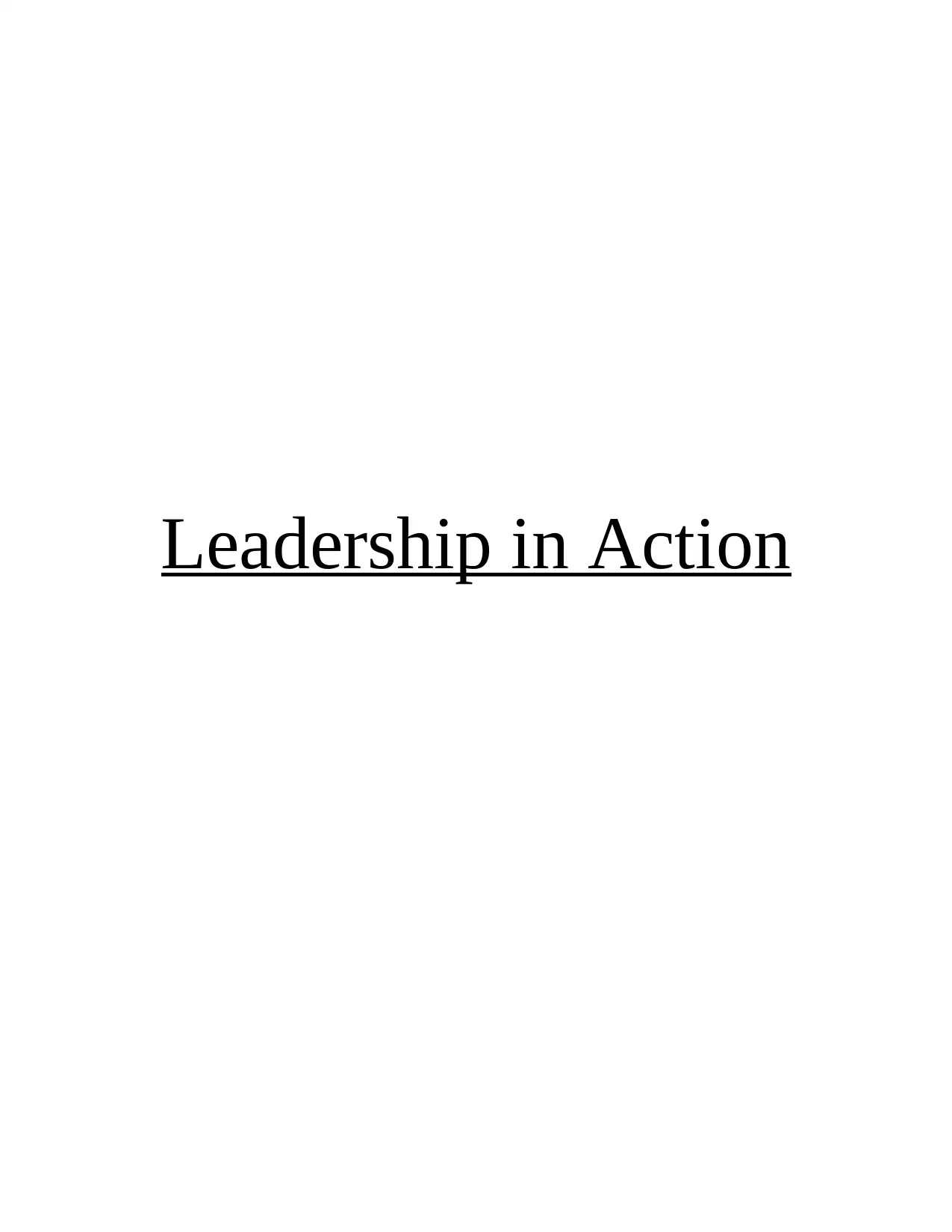
Leadership in Action
Paraphrase This Document
Need a fresh take? Get an instant paraphrase of this document with our AI Paraphraser
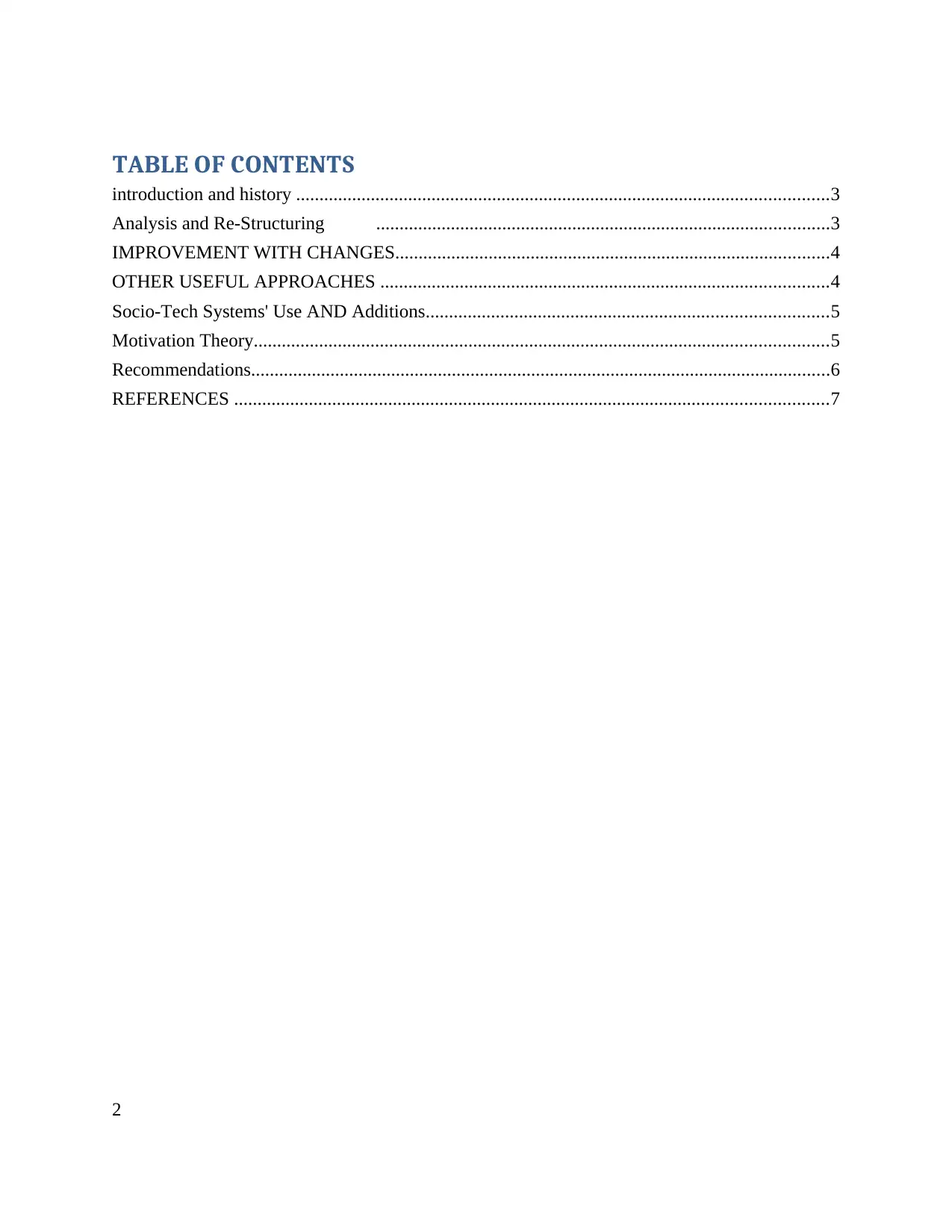
TABLE OF CONTENTS
introduction and history ..................................................................................................................3
Analysis and Re-Structuring .................................................................................................3
IMPROVEMENT WITH CHANGES.............................................................................................4
OTHER USEFUL APPROACHES ................................................................................................4
Socio-Tech Systems' Use AND Additions......................................................................................5
Motivation Theory...........................................................................................................................5
Recommendations............................................................................................................................6
REFERENCES ...............................................................................................................................7
2
introduction and history ..................................................................................................................3
Analysis and Re-Structuring .................................................................................................3
IMPROVEMENT WITH CHANGES.............................................................................................4
OTHER USEFUL APPROACHES ................................................................................................4
Socio-Tech Systems' Use AND Additions......................................................................................5
Motivation Theory...........................................................................................................................5
Recommendations............................................................................................................................6
REFERENCES ...............................................................................................................................7
2
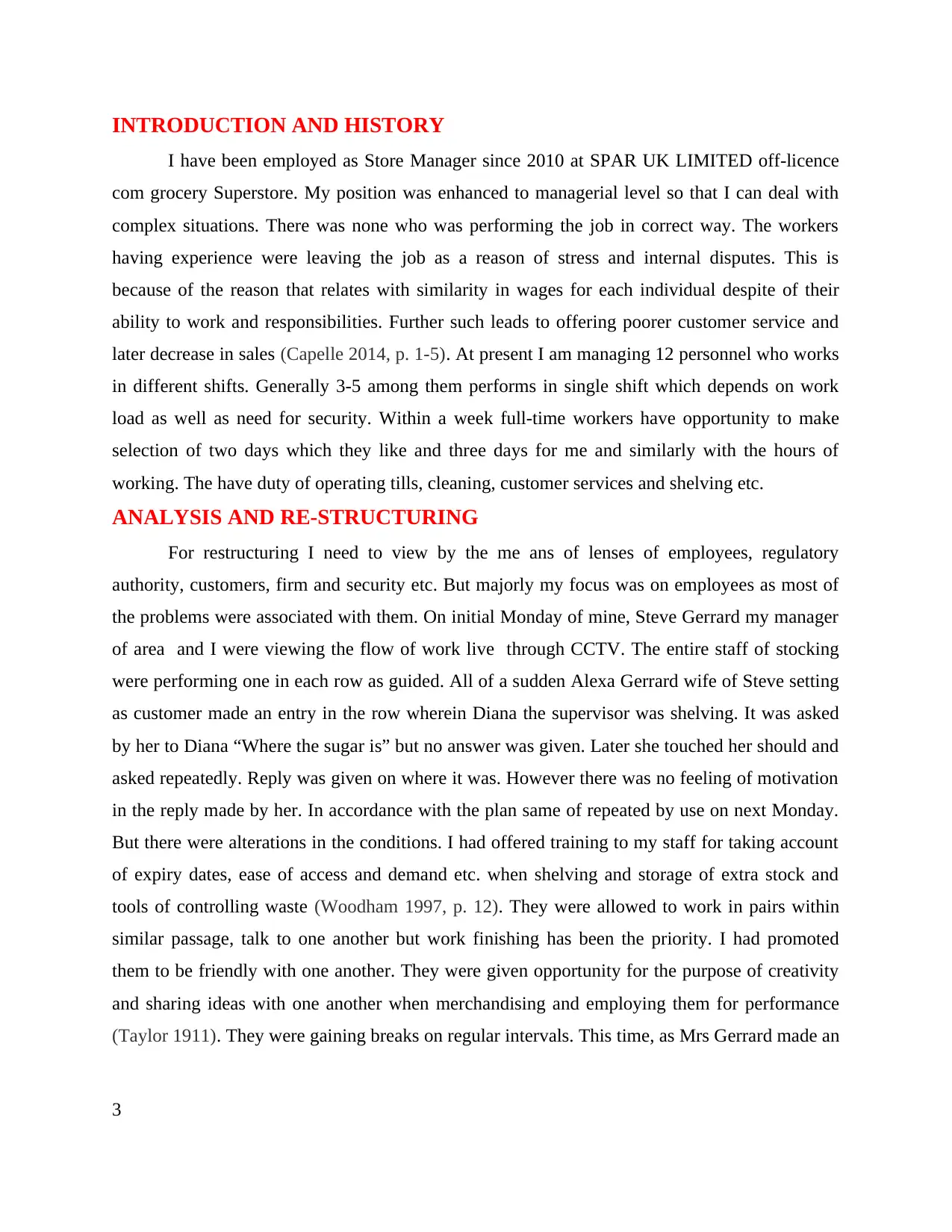
INTRODUCTION AND HISTORY
I have been employed as Store Manager since 2010 at SPAR UK LIMITED off-licence
com grocery Superstore. My position was enhanced to managerial level so that I can deal with
complex situations. There was none who was performing the job in correct way. The workers
having experience were leaving the job as a reason of stress and internal disputes. This is
because of the reason that relates with similarity in wages for each individual despite of their
ability to work and responsibilities. Further such leads to offering poorer customer service and
later decrease in sales (Capelle 2014, p. 1-5). At present I am managing 12 personnel who works
in different shifts. Generally 3-5 among them performs in single shift which depends on work
load as well as need for security. Within a week full-time workers have opportunity to make
selection of two days which they like and three days for me and similarly with the hours of
working. The have duty of operating tills, cleaning, customer services and shelving etc.
ANALYSIS AND RE-STRUCTURING
For restructuring I need to view by the me ans of lenses of employees, regulatory
authority, customers, firm and security etc. But majorly my focus was on employees as most of
the problems were associated with them. On initial Monday of mine, Steve Gerrard my manager
of area and I were viewing the flow of work live through CCTV. The entire staff of stocking
were performing one in each row as guided. All of a sudden Alexa Gerrard wife of Steve setting
as customer made an entry in the row wherein Diana the supervisor was shelving. It was asked
by her to Diana “Where the sugar is” but no answer was given. Later she touched her should and
asked repeatedly. Reply was given on where it was. However there was no feeling of motivation
in the reply made by her. In accordance with the plan same of repeated by use on next Monday.
But there were alterations in the conditions. I had offered training to my staff for taking account
of expiry dates, ease of access and demand etc. when shelving and storage of extra stock and
tools of controlling waste (Woodham 1997, p. 12). They were allowed to work in pairs within
similar passage, talk to one another but work finishing has been the priority. I had promoted
them to be friendly with one another. They were given opportunity for the purpose of creativity
and sharing ideas with one another when merchandising and employing them for performance
(Taylor 1911). They were gaining breaks on regular intervals. This time, as Mrs Gerrard made an
3
I have been employed as Store Manager since 2010 at SPAR UK LIMITED off-licence
com grocery Superstore. My position was enhanced to managerial level so that I can deal with
complex situations. There was none who was performing the job in correct way. The workers
having experience were leaving the job as a reason of stress and internal disputes. This is
because of the reason that relates with similarity in wages for each individual despite of their
ability to work and responsibilities. Further such leads to offering poorer customer service and
later decrease in sales (Capelle 2014, p. 1-5). At present I am managing 12 personnel who works
in different shifts. Generally 3-5 among them performs in single shift which depends on work
load as well as need for security. Within a week full-time workers have opportunity to make
selection of two days which they like and three days for me and similarly with the hours of
working. The have duty of operating tills, cleaning, customer services and shelving etc.
ANALYSIS AND RE-STRUCTURING
For restructuring I need to view by the me ans of lenses of employees, regulatory
authority, customers, firm and security etc. But majorly my focus was on employees as most of
the problems were associated with them. On initial Monday of mine, Steve Gerrard my manager
of area and I were viewing the flow of work live through CCTV. The entire staff of stocking
were performing one in each row as guided. All of a sudden Alexa Gerrard wife of Steve setting
as customer made an entry in the row wherein Diana the supervisor was shelving. It was asked
by her to Diana “Where the sugar is” but no answer was given. Later she touched her should and
asked repeatedly. Reply was given on where it was. However there was no feeling of motivation
in the reply made by her. In accordance with the plan same of repeated by use on next Monday.
But there were alterations in the conditions. I had offered training to my staff for taking account
of expiry dates, ease of access and demand etc. when shelving and storage of extra stock and
tools of controlling waste (Woodham 1997, p. 12). They were allowed to work in pairs within
similar passage, talk to one another but work finishing has been the priority. I had promoted
them to be friendly with one another. They were given opportunity for the purpose of creativity
and sharing ideas with one another when merchandising and employing them for performance
(Taylor 1911). They were gaining breaks on regular intervals. This time, as Mrs Gerrard made an
3
⊘ This is a preview!⊘
Do you want full access?
Subscribe today to unlock all pages.

Trusted by 1+ million students worldwide
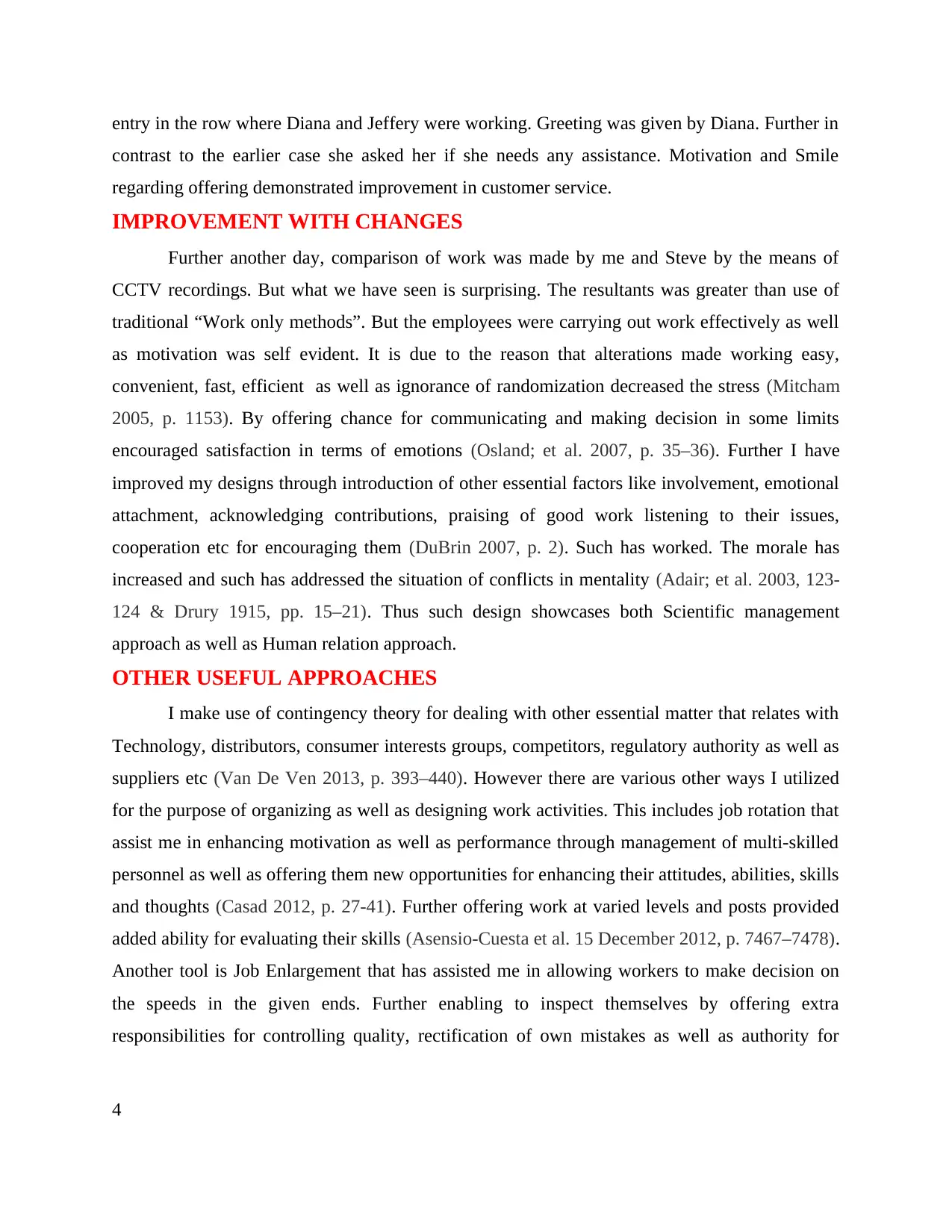
entry in the row where Diana and Jeffery were working. Greeting was given by Diana. Further in
contrast to the earlier case she asked her if she needs any assistance. Motivation and Smile
regarding offering demonstrated improvement in customer service.
IMPROVEMENT WITH CHANGES
Further another day, comparison of work was made by me and Steve by the means of
CCTV recordings. But what we have seen is surprising. The resultants was greater than use of
traditional “Work only methods”. But the employees were carrying out work effectively as well
as motivation was self evident. It is due to the reason that alterations made working easy,
convenient, fast, efficient as well as ignorance of randomization decreased the stress (Mitcham
2005, p. 1153). By offering chance for communicating and making decision in some limits
encouraged satisfaction in terms of emotions (Osland; et al. 2007, p. 35–36). Further I have
improved my designs through introduction of other essential factors like involvement, emotional
attachment, acknowledging contributions, praising of good work listening to their issues,
cooperation etc for encouraging them (DuBrin 2007, p. 2). Such has worked. The morale has
increased and such has addressed the situation of conflicts in mentality (Adair; et al. 2003, 123-
124 & Drury 1915, pp. 15–21). Thus such design showcases both Scientific management
approach as well as Human relation approach.
OTHER USEFUL APPROACHES
I make use of contingency theory for dealing with other essential matter that relates with
Technology, distributors, consumer interests groups, competitors, regulatory authority as well as
suppliers etc (Van De Ven 2013, p. 393–440). However there are various other ways I utilized
for the purpose of organizing as well as designing work activities. This includes job rotation that
assist me in enhancing motivation as well as performance through management of multi-skilled
personnel as well as offering them new opportunities for enhancing their attitudes, abilities, skills
and thoughts (Casad 2012, p. 27-41). Further offering work at varied levels and posts provided
added ability for evaluating their skills (Asensio-Cuesta et al. 15 December 2012, p. 7467–7478).
Another tool is Job Enlargement that has assisted me in allowing workers to make decision on
the speeds in the given ends. Further enabling to inspect themselves by offering extra
responsibilities for controlling quality, rectification of own mistakes as well as authority for
4
contrast to the earlier case she asked her if she needs any assistance. Motivation and Smile
regarding offering demonstrated improvement in customer service.
IMPROVEMENT WITH CHANGES
Further another day, comparison of work was made by me and Steve by the means of
CCTV recordings. But what we have seen is surprising. The resultants was greater than use of
traditional “Work only methods”. But the employees were carrying out work effectively as well
as motivation was self evident. It is due to the reason that alterations made working easy,
convenient, fast, efficient as well as ignorance of randomization decreased the stress (Mitcham
2005, p. 1153). By offering chance for communicating and making decision in some limits
encouraged satisfaction in terms of emotions (Osland; et al. 2007, p. 35–36). Further I have
improved my designs through introduction of other essential factors like involvement, emotional
attachment, acknowledging contributions, praising of good work listening to their issues,
cooperation etc for encouraging them (DuBrin 2007, p. 2). Such has worked. The morale has
increased and such has addressed the situation of conflicts in mentality (Adair; et al. 2003, 123-
124 & Drury 1915, pp. 15–21). Thus such design showcases both Scientific management
approach as well as Human relation approach.
OTHER USEFUL APPROACHES
I make use of contingency theory for dealing with other essential matter that relates with
Technology, distributors, consumer interests groups, competitors, regulatory authority as well as
suppliers etc (Van De Ven 2013, p. 393–440). However there are various other ways I utilized
for the purpose of organizing as well as designing work activities. This includes job rotation that
assist me in enhancing motivation as well as performance through management of multi-skilled
personnel as well as offering them new opportunities for enhancing their attitudes, abilities, skills
and thoughts (Casad 2012, p. 27-41). Further offering work at varied levels and posts provided
added ability for evaluating their skills (Asensio-Cuesta et al. 15 December 2012, p. 7467–7478).
Another tool is Job Enlargement that has assisted me in allowing workers to make decision on
the speeds in the given ends. Further enabling to inspect themselves by offering extra
responsibilities for controlling quality, rectification of own mistakes as well as authority for
4
Paraphrase This Document
Need a fresh take? Get an instant paraphrase of this document with our AI Paraphraser
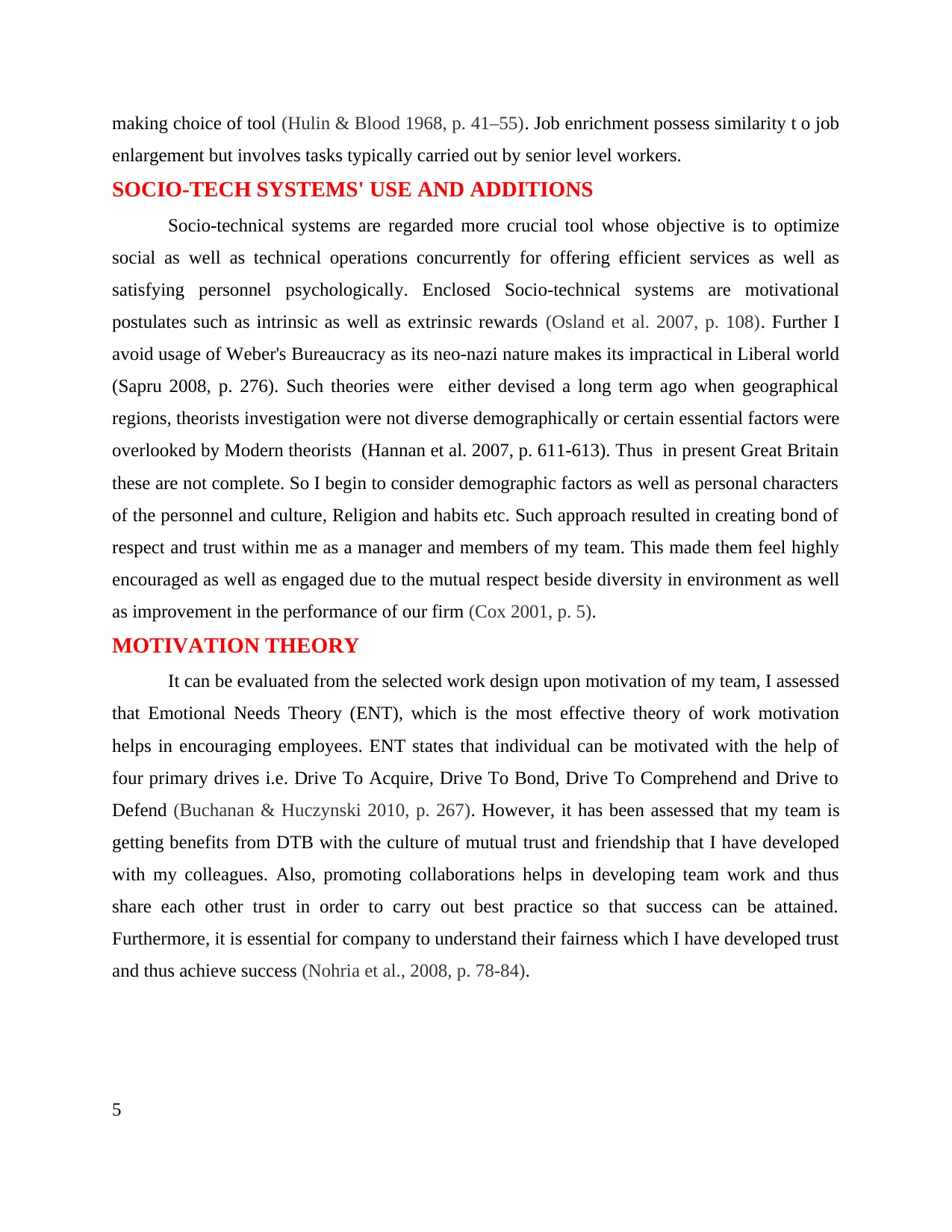
making choice of tool (Hulin & Blood 1968, p. 41–55). Job enrichment possess similarity t o job
enlargement but involves tasks typically carried out by senior level workers.
SOCIO-TECH SYSTEMS' USE AND ADDITIONS
Socio-technical systems are regarded more crucial tool whose objective is to optimize
social as well as technical operations concurrently for offering efficient services as well as
satisfying personnel psychologically. Enclosed Socio-technical systems are motivational
postulates such as intrinsic as well as extrinsic rewards (Osland et al. 2007, p. 108). Further I
avoid usage of Weber's Bureaucracy as its neo-nazi nature makes its impractical in Liberal world
(Sapru 2008, p. 276). Such theories were either devised a long term ago when geographical
regions, theorists investigation were not diverse demographically or certain essential factors were
overlooked by Modern theorists (Hannan et al. 2007, p. 611-613). Thus in present Great Britain
these are not complete. So I begin to consider demographic factors as well as personal characters
of the personnel and culture, Religion and habits etc. Such approach resulted in creating bond of
respect and trust within me as a manager and members of my team. This made them feel highly
encouraged as well as engaged due to the mutual respect beside diversity in environment as well
as improvement in the performance of our firm (Cox 2001, p. 5).
MOTIVATION THEORY
It can be evaluated from the selected work design upon motivation of my team, I assessed
that Emotional Needs Theory (ENT), which is the most effective theory of work motivation
helps in encouraging employees. ENT states that individual can be motivated with the help of
four primary drives i.e. Drive To Acquire, Drive To Bond, Drive To Comprehend and Drive to
Defend (Buchanan & Huczynski 2010, p. 267). However, it has been assessed that my team is
getting benefits from DTB with the culture of mutual trust and friendship that I have developed
with my colleagues. Also, promoting collaborations helps in developing team work and thus
share each other trust in order to carry out best practice so that success can be attained.
Furthermore, it is essential for company to understand their fairness which I have developed trust
and thus achieve success (Nohria et al., 2008, p. 78-84).
5
enlargement but involves tasks typically carried out by senior level workers.
SOCIO-TECH SYSTEMS' USE AND ADDITIONS
Socio-technical systems are regarded more crucial tool whose objective is to optimize
social as well as technical operations concurrently for offering efficient services as well as
satisfying personnel psychologically. Enclosed Socio-technical systems are motivational
postulates such as intrinsic as well as extrinsic rewards (Osland et al. 2007, p. 108). Further I
avoid usage of Weber's Bureaucracy as its neo-nazi nature makes its impractical in Liberal world
(Sapru 2008, p. 276). Such theories were either devised a long term ago when geographical
regions, theorists investigation were not diverse demographically or certain essential factors were
overlooked by Modern theorists (Hannan et al. 2007, p. 611-613). Thus in present Great Britain
these are not complete. So I begin to consider demographic factors as well as personal characters
of the personnel and culture, Religion and habits etc. Such approach resulted in creating bond of
respect and trust within me as a manager and members of my team. This made them feel highly
encouraged as well as engaged due to the mutual respect beside diversity in environment as well
as improvement in the performance of our firm (Cox 2001, p. 5).
MOTIVATION THEORY
It can be evaluated from the selected work design upon motivation of my team, I assessed
that Emotional Needs Theory (ENT), which is the most effective theory of work motivation
helps in encouraging employees. ENT states that individual can be motivated with the help of
four primary drives i.e. Drive To Acquire, Drive To Bond, Drive To Comprehend and Drive to
Defend (Buchanan & Huczynski 2010, p. 267). However, it has been assessed that my team is
getting benefits from DTB with the culture of mutual trust and friendship that I have developed
with my colleagues. Also, promoting collaborations helps in developing team work and thus
share each other trust in order to carry out best practice so that success can be attained.
Furthermore, it is essential for company to understand their fairness which I have developed trust
and thus achieve success (Nohria et al., 2008, p. 78-84).
5
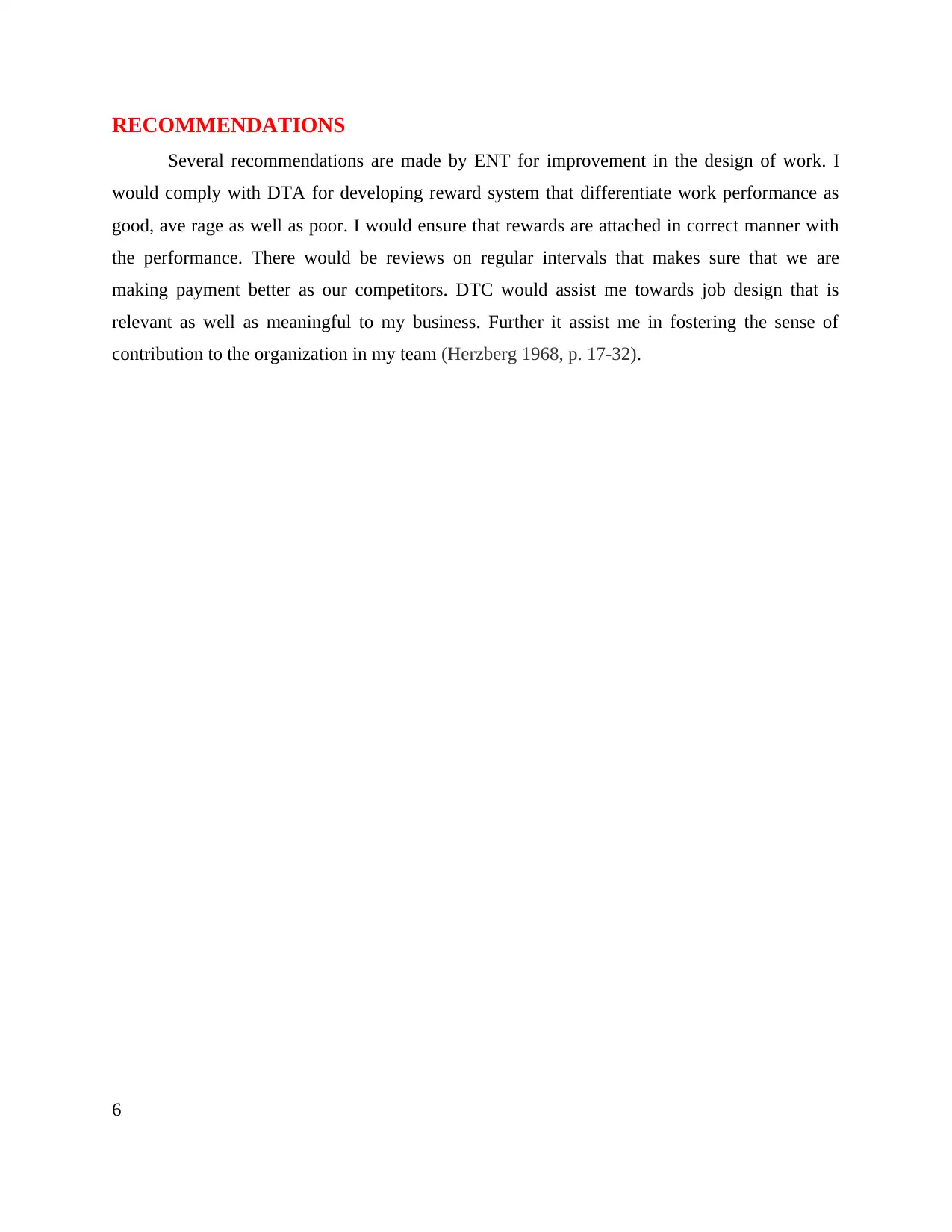
RECOMMENDATIONS
Several recommendations are made by ENT for improvement in the design of work. I
would comply with DTA for developing reward system that differentiate work performance as
good, ave rage as well as poor. I would ensure that rewards are attached in correct manner with
the performance. There would be reviews on regular intervals that makes sure that we are
making payment better as our competitors. DTC would assist me towards job design that is
relevant as well as meaningful to my business. Further it assist me in fostering the sense of
contribution to the organization in my team (Herzberg 1968, p. 17-32).
6
Several recommendations are made by ENT for improvement in the design of work. I
would comply with DTA for developing reward system that differentiate work performance as
good, ave rage as well as poor. I would ensure that rewards are attached in correct manner with
the performance. There would be reviews on regular intervals that makes sure that we are
making payment better as our competitors. DTC would assist me towards job design that is
relevant as well as meaningful to my business. Further it assist me in fostering the sense of
contribution to the organization in my team (Herzberg 1968, p. 17-32).
6
⊘ This is a preview!⊘
Do you want full access?
Subscribe today to unlock all pages.

Trusted by 1+ million students worldwide
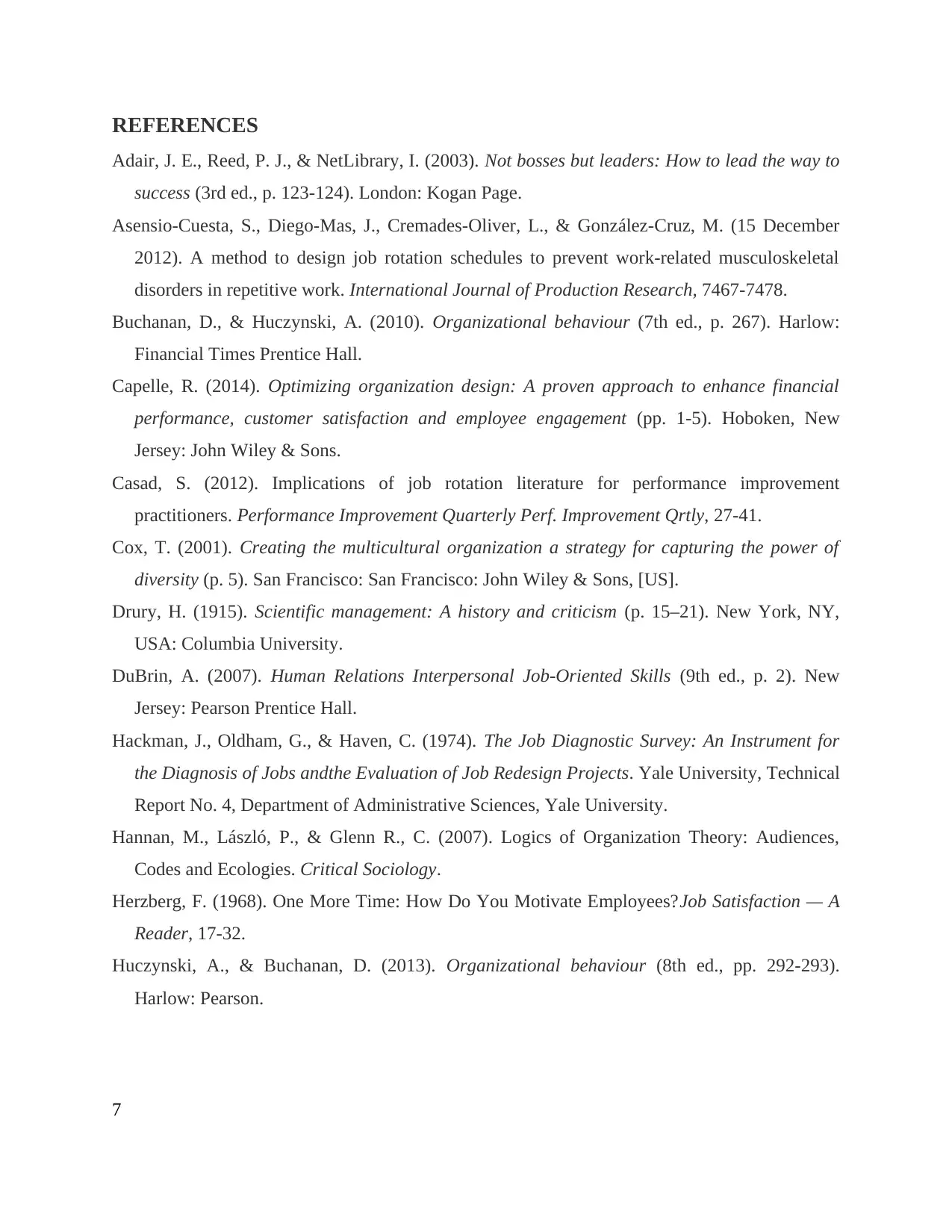
REFERENCES
Adair, J. E., Reed, P. J., & NetLibrary, I. (2003). Not bosses but leaders: How to lead the way to
success (3rd ed., p. 123-124). London: Kogan Page.
Asensio-Cuesta, S., Diego-Mas, J., Cremades-Oliver, L., & González-Cruz, M. (15 December
2012). A method to design job rotation schedules to prevent work-related musculoskeletal
disorders in repetitive work. International Journal of Production Research, 7467-7478.
Buchanan, D., & Huczynski, A. (2010). Organizational behaviour (7th ed., p. 267). Harlow:
Financial Times Prentice Hall.
Capelle, R. (2014). Optimizing organization design: A proven approach to enhance financial
performance, customer satisfaction and employee engagement (pp. 1-5). Hoboken, New
Jersey: John Wiley & Sons.
Casad, S. (2012). Implications of job rotation literature for performance improvement
practitioners. Performance Improvement Quarterly Perf. Improvement Qrtly, 27-41.
Cox, T. (2001). Creating the multicultural organization a strategy for capturing the power of
diversity (p. 5). San Francisco: San Francisco: John Wiley & Sons, [US].
Drury, H. (1915). Scientific management: A history and criticism (p. 15–21). New York, NY,
USA: Columbia University.
DuBrin, A. (2007). Human Relations Interpersonal Job-Oriented Skills (9th ed., p. 2). New
Jersey: Pearson Prentice Hall.
Hackman, J., Oldham, G., & Haven, C. (1974). The Job Diagnostic Survey: An Instrument for
the Diagnosis of Jobs andthe Evaluation of Job Redesign Projects. Yale University, Technical
Report No. 4, Department of Administrative Sciences, Yale University.
Hannan, M., László, P., & Glenn R., C. (2007). Logics of Organization Theory: Audiences,
Codes and Ecologies. Critical Sociology.
Herzberg, F. (1968). One More Time: How Do You Motivate Employees?Job Satisfaction — A
Reader, 17-32.
Huczynski, A., & Buchanan, D. (2013). Organizational behaviour (8th ed., pp. 292-293).
Harlow: Pearson.
7
Adair, J. E., Reed, P. J., & NetLibrary, I. (2003). Not bosses but leaders: How to lead the way to
success (3rd ed., p. 123-124). London: Kogan Page.
Asensio-Cuesta, S., Diego-Mas, J., Cremades-Oliver, L., & González-Cruz, M. (15 December
2012). A method to design job rotation schedules to prevent work-related musculoskeletal
disorders in repetitive work. International Journal of Production Research, 7467-7478.
Buchanan, D., & Huczynski, A. (2010). Organizational behaviour (7th ed., p. 267). Harlow:
Financial Times Prentice Hall.
Capelle, R. (2014). Optimizing organization design: A proven approach to enhance financial
performance, customer satisfaction and employee engagement (pp. 1-5). Hoboken, New
Jersey: John Wiley & Sons.
Casad, S. (2012). Implications of job rotation literature for performance improvement
practitioners. Performance Improvement Quarterly Perf. Improvement Qrtly, 27-41.
Cox, T. (2001). Creating the multicultural organization a strategy for capturing the power of
diversity (p. 5). San Francisco: San Francisco: John Wiley & Sons, [US].
Drury, H. (1915). Scientific management: A history and criticism (p. 15–21). New York, NY,
USA: Columbia University.
DuBrin, A. (2007). Human Relations Interpersonal Job-Oriented Skills (9th ed., p. 2). New
Jersey: Pearson Prentice Hall.
Hackman, J., Oldham, G., & Haven, C. (1974). The Job Diagnostic Survey: An Instrument for
the Diagnosis of Jobs andthe Evaluation of Job Redesign Projects. Yale University, Technical
Report No. 4, Department of Administrative Sciences, Yale University.
Hannan, M., László, P., & Glenn R., C. (2007). Logics of Organization Theory: Audiences,
Codes and Ecologies. Critical Sociology.
Herzberg, F. (1968). One More Time: How Do You Motivate Employees?Job Satisfaction — A
Reader, 17-32.
Huczynski, A., & Buchanan, D. (2013). Organizational behaviour (8th ed., pp. 292-293).
Harlow: Pearson.
7
Paraphrase This Document
Need a fresh take? Get an instant paraphrase of this document with our AI Paraphraser
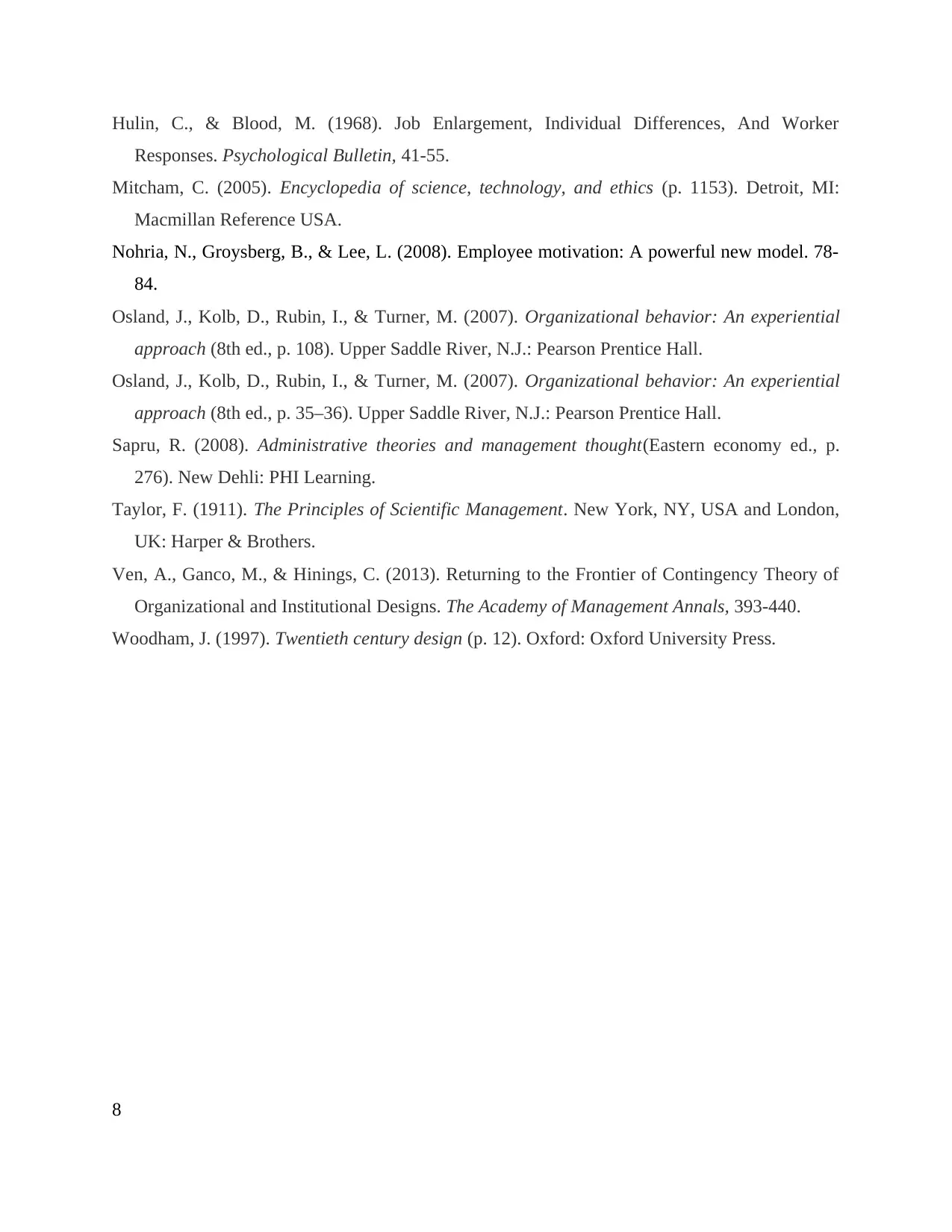
Hulin, C., & Blood, M. (1968). Job Enlargement, Individual Differences, And Worker
Responses. Psychological Bulletin, 41-55.
Mitcham, C. (2005). Encyclopedia of science, technology, and ethics (p. 1153). Detroit, MI:
Macmillan Reference USA.
Nohria, N., Groysberg, B., & Lee, L. (2008). Employee motivation: A powerful new model. 78-
84.
Osland, J., Kolb, D., Rubin, I., & Turner, M. (2007). Organizational behavior: An experiential
approach (8th ed., p. 108). Upper Saddle River, N.J.: Pearson Prentice Hall.
Osland, J., Kolb, D., Rubin, I., & Turner, M. (2007). Organizational behavior: An experiential
approach (8th ed., p. 35–36). Upper Saddle River, N.J.: Pearson Prentice Hall.
Sapru, R. (2008). Administrative theories and management thought(Eastern economy ed., p.
276). New Dehli: PHI Learning.
Taylor, F. (1911). The Principles of Scientific Management. New York, NY, USA and London,
UK: Harper & Brothers.
Ven, A., Ganco, M., & Hinings, C. (2013). Returning to the Frontier of Contingency Theory of
Organizational and Institutional Designs. The Academy of Management Annals, 393-440.
Woodham, J. (1997). Twentieth century design (p. 12). Oxford: Oxford University Press.
8
Responses. Psychological Bulletin, 41-55.
Mitcham, C. (2005). Encyclopedia of science, technology, and ethics (p. 1153). Detroit, MI:
Macmillan Reference USA.
Nohria, N., Groysberg, B., & Lee, L. (2008). Employee motivation: A powerful new model. 78-
84.
Osland, J., Kolb, D., Rubin, I., & Turner, M. (2007). Organizational behavior: An experiential
approach (8th ed., p. 108). Upper Saddle River, N.J.: Pearson Prentice Hall.
Osland, J., Kolb, D., Rubin, I., & Turner, M. (2007). Organizational behavior: An experiential
approach (8th ed., p. 35–36). Upper Saddle River, N.J.: Pearson Prentice Hall.
Sapru, R. (2008). Administrative theories and management thought(Eastern economy ed., p.
276). New Dehli: PHI Learning.
Taylor, F. (1911). The Principles of Scientific Management. New York, NY, USA and London,
UK: Harper & Brothers.
Ven, A., Ganco, M., & Hinings, C. (2013). Returning to the Frontier of Contingency Theory of
Organizational and Institutional Designs. The Academy of Management Annals, 393-440.
Woodham, J. (1997). Twentieth century design (p. 12). Oxford: Oxford University Press.
8
1 out of 8
Your All-in-One AI-Powered Toolkit for Academic Success.
+13062052269
info@desklib.com
Available 24*7 on WhatsApp / Email
![[object Object]](/_next/static/media/star-bottom.7253800d.svg)
Unlock your academic potential
Copyright © 2020–2025 A2Z Services. All Rights Reserved. Developed and managed by ZUCOL.


